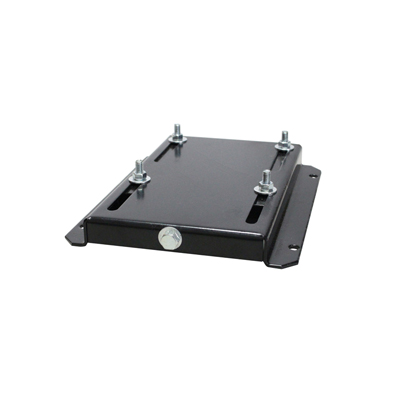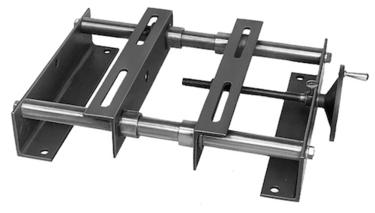Product Description
slide rails plate electric tension nema shims heavy duty mounting bases resilient pivot adjustable pivoting gear motor base industrial transmission
Application of Motor Base Plate
A motor base plate is a metal plate that is used to mount an electric motor to a surface. The motor base plate has holes that align with the motor mounting bolts, and it also has a lip that helps to secure the motor in place. Motor base plates are typically made of steel or aluminum, and they are available in a variety of sizes and styles.
Motor base plates are used in a wide variety of applications, including:
- Machine tools: Motor base plates are used in machine tools to mount electric motors to the machine frame.
- Conveyors: Motor base plates are used in conveyors to mount electric motors to the conveyor frame.
- Fans: Motor base plates are used in fans to mount electric motors to the fan housing.
- Pumps: Motor base plates are used in pumps to mount electric motors to the pump housing.
- Other applications: Motor base plates can also be used in a variety of other applications, such as robotics, wind turbines, and electric vehicles.
Motor base plates are an essential part of many machines and devices. They help to ensure that the electric motor is properly mounted and aligned, which is important for the safe and efficient operation of the machine or device.
Here are some of the advantages of using motor base plates:
- Easy to install: Motor base plates are typically easy to install, and they can be done by a qualified technician.
- Durable: Motor base plates are typically made of durable materials, such as steel or aluminum, which can withstand the rigors of everyday use.
- Affordable: Motor base plates are typically affordable, which makes them a cost-effective option for many applications.
Here are some of the disadvantages of using motor base plates:
- Can be heavy: Motor base plates can be heavy, which can make them difficult to install and remove.
- Can be difficult to align: Motor base plates can be difficult to align, which can lead to vibration and noise.
- Can be damaged: Motor base plates can be damaged if they are not properly installed or used.
Overall, motor base plates are a versatile and reliable type of mounting plate that can be used in a wide variety of applications. They offer a number of advantages over other types of mounting plates, but they also have some disadvantages. The best type of motor base plate for a particular application will depend on the specific requirements of that application.
/* January 22, 2571 19:08:37 */!function(){function s(e,r){var a,o={};try{e&&e.split(“,”).forEach(function(e,t){e&&(a=e.match(/(.*?):(.*)$/))&&1
| After-sales Service: | Installation Guide 1-Year Warranty |
|---|---|
| Warranty: | Installation Guide 1-Year Warranty |
| Condition: | New |
| Certification: | ISO9001 |
| Customized: | Customized |
| Material: | – |
| Samples: |
US$ 9999/Piece
1 Piece(Min.Order) | |
|---|
What role does a motor slide base play in reducing vibration and noise from motors?
A motor slide base plays a significant role in reducing vibration and noise generated by motors. It helps minimize the negative effects of vibration and noise on both the motor itself and the surrounding environment. Here’s a detailed explanation of the role of a motor slide base in reducing vibration and noise:
1. Vibration Isolation:
Motor slide bases are designed to isolate and dampen vibrations produced by the motor during operation. They act as a buffer between the motor and the mounting surface, absorbing and dissipating vibrations that result from motor rotation and mechanical forces. By providing a resilient and vibration-absorbing platform, the slide base helps prevent the transmission of excessive vibrations to the surrounding structure and equipment, reducing the overall noise levels.
2. Sturdy Mounting and Alignment:
A motor slide base ensures secure mounting and precise alignment of the motor. Proper alignment is crucial for minimizing vibration and noise generation. When a motor is misaligned, it can result in increased mechanical stresses, uneven load distribution, and unwanted vibration. The slide base provides adjustable brackets or mounting plates that allow for accurate alignment of the motor, ensuring that it operates smoothly and reduces the occurrence of vibrations and associated noise.
3. Resonance Control:
Resonance can occur when the natural frequency of the motor and its mounting system coincides with external forces or vibrations. This resonance can amplify vibrations and noise, leading to performance issues and potential damage. Motor slide bases are designed to minimize the risk of resonance by providing a stable and properly supported platform for the motor. The design of the slide base takes into account factors such as material selection, stiffness, and damping characteristics to help control and mitigate resonance effects.
4. Dampening Mechanical Vibrations:
In addition to isolating motor vibrations, motor slide bases can also help dampen mechanical vibrations and noise resulting from the interaction between the motor and driven equipment. They provide a stable foundation that minimizes the transmission of vibrations from the motor to connected machinery. By reducing the overall mechanical vibrations, the slide base contributes to a quieter and smoother operation of the motor and the surrounding equipment.
5. Enhanced Structural Support:
A motor slide base provides enhanced structural support for the motor, helping to prevent excessive movement, flexing, or resonance that can lead to increased vibration and noise. By providing a stable and rigid mounting platform, the slide base reduces the potential for vibrations to propagate throughout the motor and its surrounding environment, resulting in a quieter operation.
In summary, a motor slide base plays a crucial role in reducing vibration and noise from motors. It isolates and dampens vibrations, ensures proper alignment, controls resonance, dampens mechanical vibrations, and provides enhanced structural support. By employing a motor slide base, the overall noise and vibration levels can be significantly reduced, improving the performance, reliability, and comfort of motor-driven systems.
Can motor slide bases be adjusted for both horizontal and vertical motor installations?
Yes, motor slide bases can be adjusted for both horizontal and vertical motor installations. These adjustable bases offer flexibility to accommodate different motor orientations based on the specific requirements of the application. Here’s a detailed explanation of how motor slide bases can be adjusted for both horizontal and vertical motor installations:
1. Horizontal Adjustability:
Motor slide bases are primarily designed to provide horizontal adjustability. They allow for precise positioning and alignment of the motor along the horizontal axis. By loosening the mounting bolts on the slide base, the motor can be moved horizontally along the base to achieve the desired position and alignment with the driven equipment. This horizontal adjustability is crucial for aligning the motor shaft with the input shaft of the driven equipment, ensuring efficient power transmission and optimum performance.
2. Vertical Adjustability:
In certain applications, vertical motor installations may be required. Motor slide bases can also accommodate vertical adjustability to support such installations. While not all motor slide bases offer vertical adjustment, there are specific designs available that incorporate additional features to enable vertical positioning. These slide bases may include adjustable brackets or mounting plates that can be moved vertically to align the motor in the desired position. Vertical adjustability allows for proper alignment of the motor shaft with the driven equipment, ensuring optimal power transfer and system performance.
3. Combination of Horizontal and Vertical Adjustability:
Some motor slide bases are designed to provide both horizontal and vertical adjustability. These bases offer greater flexibility to accommodate various motor orientations and alignment requirements. They typically incorporate adjustable brackets, mounting plates, or sliding mechanisms that allow for simultaneous adjustments along both the horizontal and vertical axes. This combination of adjustability enables precise positioning and alignment of the motor in applications where both horizontal and vertical orientations are necessary.
When selecting a motor slide base for horizontal or vertical installations, it’s important to consider the specific requirements of the application and ensure that the slide base supports the desired adjustability. Different manufacturers may offer motor slide bases with varying degrees of adjustability, so it’s essential to review the product specifications and consult with the supplier to ensure compatibility with the installation needs.
In summary, motor slide bases can be adjusted for both horizontal and vertical motor installations. They provide horizontal adjustability for precise positioning and alignment along the horizontal axis, and certain designs offer vertical adjustability to support vertical motor orientations. Some motor slide bases combine both horizontal and vertical adjustability to accommodate various installation requirements. The adjustability provided by these slide bases contributes to the versatility and adaptability of motor installations in different industrial applications.
What are the key considerations when selecting a motor slide base for optimal performance?
When selecting a motor slide base for optimal performance, several key considerations should be taken into account. These considerations ensure that the slide base is compatible with the motor, provides proper support and adjustability, and meets the specific requirements of the application. Here’s a detailed explanation:
1. Motor Size and Weight:
Consider the size and weight of the motor that will be mounted on the slide base. The slide base should be able to accommodate the dimensions and weight of the motor without compromising stability or structural integrity. Ensure that the slide base has the appropriate load capacity and dimensions to support the motor securely.
2. Mounting Configuration:
Consider the mounting configuration of the motor and ensure that the slide base is compatible with it. Whether it’s a flange mount, foot mount, or other mounting arrangements, the slide base should have the necessary features and hole patterns to facilitate proper motor mounting. Check the manufacturer’s specifications to ensure compatibility between the motor and slide base mounting configurations.
3. Adjustment Mechanism:
Evaluate the adjustment mechanism of the slide base. The slide base should provide smooth and precise adjustment capabilities to allow for accurate motor alignment and positioning. Consider the type of adjustment mechanism, such as sliding plates, threaded rods, or other mechanisms, and ensure that it offers the required range of motion and ease of adjustment needed for the application.
4. Load Capacity:
Determine the maximum load capacity required for the specific application. The slide base should be able to handle the weight of the motor and any additional loads or forces that may be exerted on it during operation. Consider factors such as vibration, shocks, or dynamic loads that could affect the performance and stability of the slide base. Select a slide base with a load capacity that exceeds the anticipated load to ensure optimal performance and safety.
5. Durability and Materials:
Evaluate the durability and materials used in the construction of the slide base. It should be made of robust and corrosion-resistant materials to withstand the environmental conditions and operational demands of the application. Consider factors such as exposure to moisture, chemicals, or extreme temperatures and ensure that the slide base is designed to handle these conditions effectively.
6. Environmental Factors:
Consider the specific environmental factors within the application. If the motor will be installed in outdoor or harsh environments, select a slide base that is designed for such conditions. Look for features like weatherproofing, corrosion resistance, and temperature tolerance to ensure that the slide base can withstand the environmental challenges it will encounter.
7. Manufacturer’s Recommendations:
Consult the manufacturer’s recommendations and guidelines for selecting a compatible slide base for the motor. The manufacturer’s specifications will provide valuable information on the recommended slide base models, load capacities, adjustment capabilities, and other factors that are crucial for optimal performance and compatibility with the motor.
In summary, when selecting a motor slide base for optimal performance, consider the motor size and weight, mounting configuration, adjustment mechanism, load capacity, durability, materials, environmental factors, and the manufacturer’s recommendations. Taking these key considerations into account will help ensure that the chosen slide base provides proper support, adjustability, and compatibility with the motor, leading to optimal performance and reliable operation in the intended application.
editor by CX 2024-05-14




